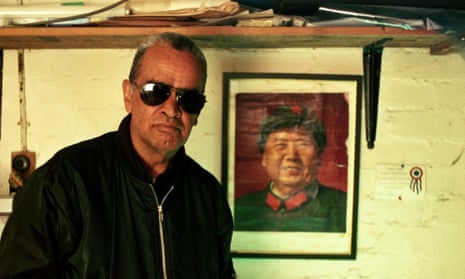There is an infamous clip of Gary Foley at the 1972 Aboriginal Tent Embassy berating an elderly white woman as being part of the problem. The moment, captured in the documentary Ningla A Na, shows Foley as young, brash and charismatic. His fiery language also has strong tones of truth, too – white people had been in charge and stuffed it up; it was time for Aboriginal people to take matters into their own hands.
Those who only know Foley as the “angry activist” will be surprised to find he has been the recipient of the prestigious Red Ochre Award for “outstanding contributions to the recognition of Aboriginal and Torres Strait Islander arts, both nationally and internationally”.
In his one man show, Foley, presented by Ilbijerri Theatre, Melbourne Festival and Sydney Festival and for performed at the Opera House in 2012, Foley opens with the clip from Ningla A Na. He laughs at himself and reflects he’s toned down a lot since then.
His role in the tent embassy can sometimes eclipse his many other achievements. But it is also true that terms such as “radical”, “activist”, “angry” and “troublemaker” imply that the drive is pure passion and emotion, not intellectual. Foley has the latter in large doses.
Foley was involved in the formation of community initiatives such as Redfern’s Aboriginal Legal Service and the Aboriginal Medical Service in Melbourne at the same time as he played role after role in the arts: sketch comedy television, starring in feature films, one-man stage performer, arts administrator and documentary filmmaker. What has been consistent is a position of advocacy that continually argued for Aboriginal and Torres Strait Islander people to have the central role in the telling of the stories about themselves and for the funding of a vibrant Indigenous arts sector.
In writing Screen Classics: Rabbit Proof Fence, I had the opportunity to revisit Foley’s role in Philip Noyce’s 1977 road movie, Backroads. It is the story of two men on a trip on the backroads of NSW in a stolen car. Foley co-stars with Bill Hunter. It is arguable that Noyce could not have made Rabbit Proof Fence – or at least not created a story that does not lose its Indigenous voice – if he had not had the experience of working with Foley.
Noyce had been shown newspaper articles about Gary Foley as he was casting the film. Noyce recounts:
I was told to ring Gary at a pub in the Aboriginal ghetto of Redfern called The Cricketer’s Arms. I rang and went over to this pub full of Aborigines and told Gary that I wanted to be a movie star. And Gary said he didn’t want any part of white man’s bullshit unless he got to monitor all of the black content. So we reached an agreement that he could rewrite his dialogue whenever he thought it was bullshit…
Foley took a key role in negotiating with the Aboriginal communities where the filming took place and played a key role with the script and the plot. It was in almost every way his film.
There seems much in this account of his interactions with Noyce that is a representation of Foley’s relationship with broader Australia. He provokes. He makes them come to him. He is unyielding. He expects them to take responsibility for fixing their ignorance. And they are the wiser for the experience.
As my own career has unfolded, I have come to more deeply understand the links between advocacy for social and legal change and creative expression, how the drive for law and policy change cannot be achieved without a broader educative program, often most effectively though the arts. With this agenda in mind one can lament recent cuts to the arts budget.
The Red Ochre award for Foley’s achievements in the arts comes on the heels of another accolade last year that also acknowledged a broader contribution to public life. Foley was awarded the University of Melbourne’s prestigious Chancellor’s Award for Excellence for his doctoral thesis, an autobiographical narrative of the Black Power Movement and the 1972 Aboriginal Embassy.
The award is a sign of the intellectual rigour of Foley’s work that brought together a critique of the canon, archival research, including his own Asio files, and his personal insights and reflections. I was one of the markers and it was one of the best I’ve read. The resulting book will be an important contribution to how we understand the period of activism in the 1970s and a clear articulation of the intellectual force behind it.
Gary Foley’s renaissance is a reminder of the interplay between the arts and the agenda for long-term and important structural change; between protest in the street and an intellectual agenda for societal transformation.
- Larissa Behrendt nominated Gary Foley for the Red Ochre award.

